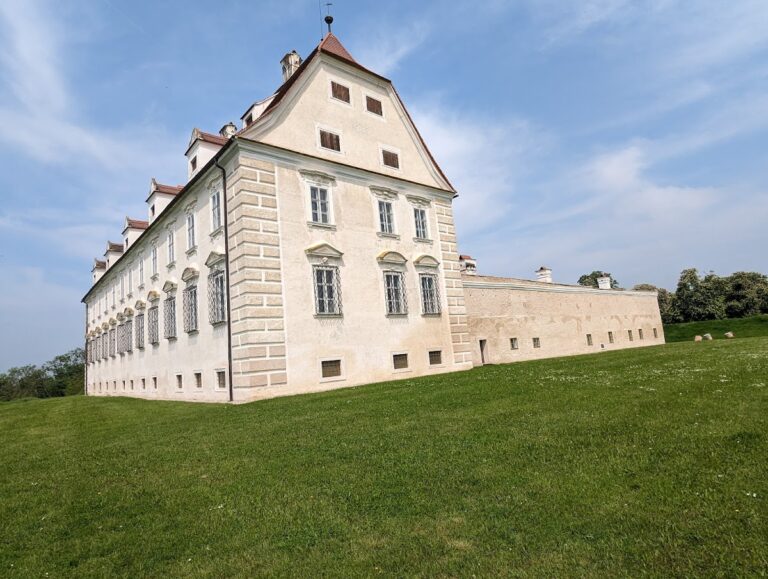Schloss Atzenbrugg: A Medieval Castle and Franz Schubert Museum in Austria
Visitor Information
Google Rating: 4.5
Popularity: Low
Google Maps: View on Google Maps
Official Website: www.schubertschloss.at
Country: Austria
Civilization: Unclassified
Remains: Military
History
Schloss Atzenbrugg is situated in the market town of Atzenbrugg in Austria and has origins dating back to the medieval period. The site takes its name from a local owner named Azzo, whose possession in the early 12th century is among the earliest documented references. The region shows signs of much earlier habitation, including Celtic and Carolingian communities, indicating a long history of settlement before the castle’s development.
During the Middle Ages, the castle was constructed as a fortified residence featuring a surrounding ring moat. From 1379 onward, it came under the ownership of the monastery Stift Klosterneuburg. In 1398, the castle chapel was expanded and consecrated to Saint Catherine, demonstrating the integration of ecclesiastical functions within the castle complex.
The castle sustained heavy damage during the second Ottoman siege of Vienna between 1683 and 1686. Restoration efforts quickly followed, with Italian stucco artist Domenico Piazzol carrying out significant repairs in 1691, particularly focusing on decorative plasterwork. Additional restorations took place around 1746, ensuring the castle’s continued structural stability.
In the early 19th century, Joseph Derffel, a jurist and estate overseer, managed Schloss Atzenbrugg. The castle became a cultural hub through the influence of his nephew, Franz von Schober. This connection brought composer Franz Schubert and his acquaintances to the castle and the nearby site of Aumühle for musical events and social gatherings known as Schubertiades. These celebrations occurred mostly between 1820 and 1822, with some sources suggesting they might have extended to 1823.
Since 1977, the municipality of Atzenbrugg has owned the castle and established it as a museum dedicated to the life and works of Franz Schubert. In the latter part of the 20th century, enthusiasts such as Rosa Schwab played a key role in organizing concert cycles featuring internationally recognized Schubert interpreters. The proceeds from these events facilitated the castle’s restoration and the creation of a dedicated Schubert Museum, which was honored with the Austrian Museum Award recognition prize in 1996.
Among the museum’s notable exhibits is a lock of Franz Schubert’s hair. This item originated from the collection of Ignaz Weinmann, a researcher who specialized in Schubert studies, and is currently preserved by the Vienna Library. More recently, Ildikó Raimondi was appointed in February 2024 as the artistic director of the Atzenbrugg Schubertiades, continuing the site’s musical legacy.
Remains
The layout of Schloss Atzenbrugg reflects its medieval roots, originally featuring a ring-shaped moat encircling the main structure. This defensive element was typical of smaller fortified manor houses and served to protect the inhabitants against potential attackers.
Central to the castle complex was a chapel, which was considerably enlarged in 1398 and consecrated to Saint Catherine. This religious building formed a significant part of the castle’s identity by combining spiritual functions with its residential and defensive roles.
Following the damage incurred during the Ottoman siege in the late 17th century, the castle underwent substantial restoration. In 1691, the Italian artist Domenico Piazzol contributed decorative stucco work, which likely enhanced both the interior and possibly exterior surfaces with ornamental plaster elements. Another phase of restoration around 1746 further preserved the building, though details of alterations from this later period are not specifically described.
Today, Schloss Atzenbrugg stands as a protected historic monument housing a museum dedicated to the composer Franz Schubert. Among its curated items, the museum displays personal artifacts related to Schubert and his social circle, including the distinguished lock of his hair. The castle’s proximity to the nearby site known as Aumühle is also of note, as both locations served as venues for musical gatherings during the early 19th century.
The castle remains a well-preserved example of a medieval fortified manor that has adapted over centuries, reflecting layers of ownership, cultural activity, and historical restoration efforts.










